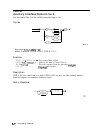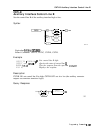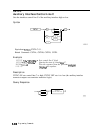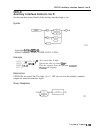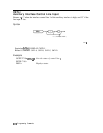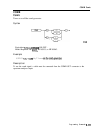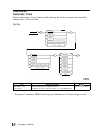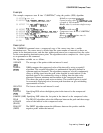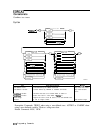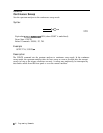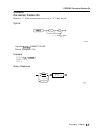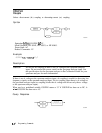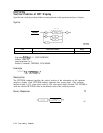
COMPRESS Compress Trace
Example
This example compresses trace B into “C-0MPTRAC” using the positive (POS) algorithm.
10 OUTPUT
718."IP-"
20 OUTPUT
718;"TR;EF
C-OMPTRAC,lOO;"
30 OUTPUT 718
;“BLANK
TRA;
SNGLS;"
40 OUTPUT
718;"CLRW
TRB;TS;"
50 OUTPUT
718;"COMPRESS
C-OMPTRAC,TRB,POS;"
60 OUTPUT
718;"BLANK
TRB;"
70 OUTPUT 718;"MOV
TRA,C-OMPTRAC;"
80 OUTPUT
718;"VIEW
TRA;"
90
END
Initializes spectrum analyz4x
Creates a trace called C-OMFTRACwith
a length of 100 elements.
Blanks trace A, activates single-sweep
mode.
Measures with trace
B
Compresses trace B into C-OMFTRAC.
Blanks trace
B
Moves
C-OMPTRAC
into trace A.
Displays the result.
Description
The COMPRESS command stores a compressed copy of the source trace into a smaller
destination trace. The source trace is divided into the same number of intervals as there are
points in the destination trace, and the data within each interval are compressed into the value
for the corresponding destination trace point. The algorithm used to compress the data is given
as an parameter to the command.
The algorithms available are as follows:
AVERAGE
@W
The average of the points within an interval is used.
NORMAL
NW
NRM computes the compressed value of the interval by using a rosenfell
algorithm. The rosenfell algorithm is a mathematical operation defined in
spectrum analyzer firmware. The algorithm compresses a locally continuously
rising or falling signal into the peak value detected in each interval. If the
detected signal is not continuously rising or falling, then the data value
alternates between minimum and maximum in the compressed interval.
This shows the peak-to-peak noise variations. The rosenfell option is useful
for accurately displaying noise, because peak detection can give misleading
representation of noise.
NEGATIVE
(NW
The lowest value in each interval is used.
POSITIVE
Specifying POS selects the highest point in the interval as the compressed
(PW
value.
SAMPLE (SMP) Specifying SMP selects the last point in the interval as the compressed value.
PEAK
The PKAVG algorithm selects the difference between the peak and the average
AVERAGE
value of the interval as the compressed value.
(PKAVG)
PEAK PIT
The PKPIT algorithm returns the difference between the positive and the
(PKPIT)
negative peaks within the interval.
Programming Commands
5-l
13




